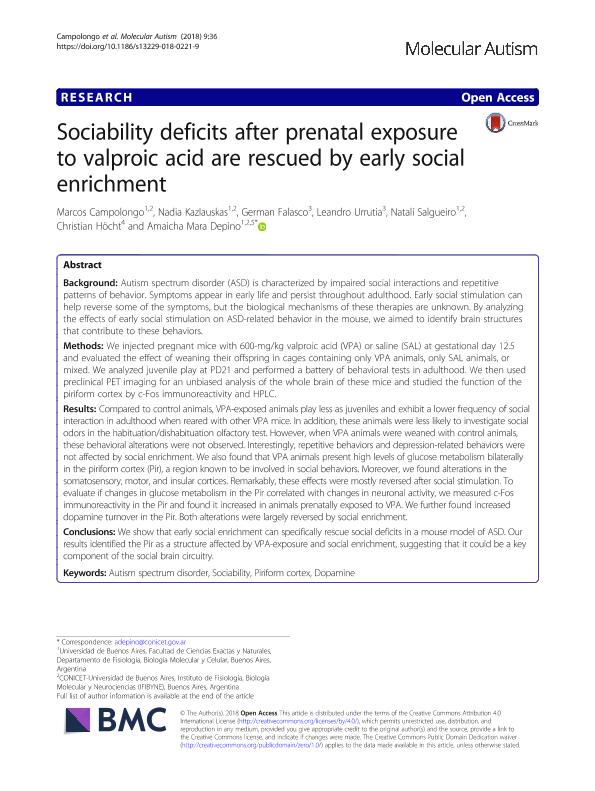Mostrar el registro sencillo del ítem
dc.contributor.author
Campolongo, Marcos Andrés

dc.contributor.author
Kazlauskas, Nadia

dc.contributor.author
Falasco, Germán Alfredo

dc.contributor.author
Urrutia, Leandro

dc.contributor.author
Salgueiro, Natalí
dc.contributor.author
Höcht, Christian

dc.contributor.author
Depino, Amaicha Mara

dc.date.available
2019-10-28T16:41:09Z
dc.date.issued
2018-06
dc.identifier.citation
Campolongo, Marcos Andrés; Kazlauskas, Nadia; Falasco, Germán Alfredo; Urrutia, Leandro; Salgueiro, Natalí; et al.; Sociability deficits after prenatal exposure to valproic acid are rescued by early social enrichment; BioMed Central; Molecular Autism; 9; 36; 6-2018; 1-17
dc.identifier.issn
2040-2392
dc.identifier.uri
http://hdl.handle.net/11336/87393
dc.description.abstract
Background: Autism spectrum disorder (ASD) is characterized by impaired social interactions and repetitive patterns of behavior. Symptoms appear in early life and persist throughout adulthood. Early social stimulation can help reverse some of the symptoms, but the biological mechanisms of these therapies are unknown. By analyzing the effects of early social stimulation on ASD-related behavior in the mouse, we aimed to identify brain structures that contribute to these behaviors. Methods: We injected pregnant mice with 600-mg/kg valproic acid (VPA) or saline (SAL) at gestational day 12.5 and evaluated the effect of weaning their offspring in cages containing only VPA animals, only SAL animals, or mixed. We analyzed juvenile play at PD21 and performed a battery of behavioral tests in adulthood. We then used preclinical PET imaging for an unbiased analysis of the whole brain of these mice and studied the function of the piriform cortex by c-Fos immunoreactivity and HPLC. Results: Compared to control animals, VPA-exposed animals play less as juveniles and exhibit a lower frequency of social interaction in adulthood when reared with other VPA mice. In addition, these animals were less likely to investigate social odors in the habituation/dishabituation olfactory test. However, when VPA animals were weaned with control animals, these behavioral alterations were not observed. Interestingly, repetitive behaviors and depression-related behaviors were not affected by social enrichment. We also found that VPA animals present high levels of glucose metabolism bilaterally in the piriform cortex (Pir), a region known to be involved in social behaviors. Moreover, we found alterations in the somatosensory, motor, and insular cortices. Remarkably, these effects were mostly reversed after social stimulation. To evaluate if changes in glucose metabolism in the Pir correlated with changes in neuronal activity, we measured c-Fos immunoreactivity in the Pir and found it increased in animals prenatally exposed to VPA. We further found increased dopamine turnover in the Pir. Both alterations were largely reversed by social enrichment. Conclusions: We show that early social enrichment can specifically rescue social deficits in a mouse model of ASD. Our results identified the Pir as a structure affected by VPA-exposure and social enrichment, suggesting that it could be a key component of the social brain circuitry.
dc.format
application/pdf
dc.language.iso
eng
dc.publisher
BioMed Central

dc.rights
info:eu-repo/semantics/openAccess
dc.rights.uri
https://creativecommons.org/licenses/by-nc-sa/2.5/ar/
dc.subject
AUTISM SPECTRUM DISORDER
dc.subject
DOPAMINE
dc.subject
PIRIFORM CORTEX
dc.subject
SOCIABILITY
dc.subject.classification
Neurociencias

dc.subject.classification
Medicina Básica

dc.subject.classification
CIENCIAS MÉDICAS Y DE LA SALUD

dc.title
Sociability deficits after prenatal exposure to valproic acid are rescued by early social enrichment
dc.type
info:eu-repo/semantics/article
dc.type
info:ar-repo/semantics/artículo
dc.type
info:eu-repo/semantics/publishedVersion
dc.date.updated
2019-10-21T19:13:55Z
dc.journal.volume
9
dc.journal.number
36
dc.journal.pagination
1-17
dc.journal.pais
Estados Unidos

dc.description.fil
Fil: Campolongo, Marcos Andrés. Consejo Nacional de Investigaciones Científicas y Técnicas. Oficina de Coordinación Administrativa Ciudad Universitaria. Instituto de Fisiología, Biología Molecular y Neurociencias. Universidad de Buenos Aires. Facultad de Ciencias Exactas y Naturales. Instituto de Fisiología, Biología Molecular y Neurociencias; Argentina
dc.description.fil
Fil: Kazlauskas, Nadia. Consejo Nacional de Investigaciones Científicas y Técnicas. Oficina de Coordinación Administrativa Ciudad Universitaria. Instituto de Fisiología, Biología Molecular y Neurociencias. Universidad de Buenos Aires. Facultad de Ciencias Exactas y Naturales. Instituto de Fisiología, Biología Molecular y Neurociencias; Argentina
dc.description.fil
Fil: Falasco, Germán Alfredo. Fundación para la Lucha contra las Enfermedades Neurológicas de la Infancia; Argentina
dc.description.fil
Fil: Urrutia, Leandro. Fundación para la Lucha contra las Enfermedades Neurológicas de la Infancia; Argentina
dc.description.fil
Fil: Salgueiro, Natalí. Consejo Nacional de Investigaciones Científicas y Técnicas. Oficina de Coordinación Administrativa Ciudad Universitaria. Instituto de Fisiología, Biología Molecular y Neurociencias. Universidad de Buenos Aires. Facultad de Ciencias Exactas y Naturales. Instituto de Fisiología, Biología Molecular y Neurociencias; Argentina
dc.description.fil
Fil: Höcht, Christian. Universidad de Buenos Aires; Argentina
dc.description.fil
Fil: Depino, Amaicha Mara. Consejo Nacional de Investigaciones Científicas y Técnicas. Oficina de Coordinación Administrativa Ciudad Universitaria. Instituto de Fisiología, Biología Molecular y Neurociencias. Universidad de Buenos Aires. Facultad de Ciencias Exactas y Naturales. Instituto de Fisiología, Biología Molecular y Neurociencias; Argentina
dc.journal.title
Molecular Autism
dc.relation.alternativeid
info:eu-repo/semantics/altIdentifier/doi/http://dx.doi.org/10.1186/s13229-018-0221-9
dc.relation.alternativeid
info:eu-repo/semantics/altIdentifier/url/https://molecularautism.biomedcentral.com/articles/10.1186/s13229-018-0221-9
Archivos asociados
